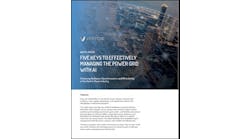New York regulators issued an order Thursday that begins the process of phasing out net metering to instead value distributed energy resources based on a range of benefits they bring to the electric grid.
Part of New York’s larger Reforming the Energy Vision policy, the order is expected to help the state reach its goal of generating half of its electricity from renewable energy by 2030.
Issued by the Public Service Commission (PSC), the 274-page decision says that the state is attempting to move away from “legacy policies” that stand in the way of new energy technologies. (Case Number 15-E-0751)
“A failure to bring the electric system and industry fully into the modern world and to keep it apace with continuing developments could have disastrous consequences, including a failure to meet modern reliability needs and expectations, enormous and avoidable costs associated with the inefficient replacement of aging components, and unchecked emissions of greenhouse gasses and other pollutants,” the order said.
What specifically does the order change?
The state places a value on distributed energy resource by gradually moving away from use of net metering and toward ‘value stacked compensation tariffs.’ The new tariffs will consider the worth of energy, capacity, environmental, demand reduction and locational relief from distributed energy resources.
Net metering remains in place for existing solar energy systems, as well as certain new solar and distributed power systems that will be installed between now and January 1, 2020 for residential and small commercial customers.
The order also establishes compensation values, for the first time in New York, for energy storage systems when combined with certain types of distributed energy.
Utilities must submit work plans to develop location-based prices that reflect the full value of distributed energy resources. The commission hopes to begin applying the new tariffs to projects as early as this summer.
In addition, the commission took action to speed development of community solar, calling for the state to issue at least $28 million for incentives.
What microgrid and distributed energy leaders say
The order won praise from several companies that are leading the way in developing microgrids and distributed energy resources.
John Westerman, vice president energy solutions, Hitachi America Limited
John Westerman, Hitachi
“This order represents a major step in fairly valuing customer-owned or third-party owned distributed energy resource (DER) systems. By providing fair valuation and clear pricing signals on a locational basis, all consumers benefit. DER adopters in high value areas are compensated based on the performance of their systems and non-adopters are not exposed to large rate-based utility capital projects that increase the cost of electricity for years and years.
This approach especially provides a mechanism to assign a more representative monetization of the many functions that electric energy storage systems can provide. Furthermore, as this model matures and the pricing signals become more dynamic, intelligent controls can be implemented to influence DER operation to maximize benefits to both the utility and the customer. This will be most evident for microgrids with multiple DER with active control systems.”
Clark Wiedetz, microgrid director for Siemens Energy Management
Clark Wiedetz. Siemens
“It is very impressive to see the New York PSC take this lead role in the continued development of distributed energy resources. Their understanding of the role that distributed generation will play in the integrated or two-way grid system demonstrates the state’s commitment to their REV initiative once again. The leaders of New York listening to their technical advisors have garnered a clear understanding of the true value of distributed generation and now energy storage as well. As pointed out by others, it will drive clean energy, increase high paying renewable energy jobs, reduce energy costs for some of the lower income communities. This is truly a victory for so many in the state.”
Justin Day, senior marketing program manager, Schweitzer Engineering Laboratories
Justin Day, Schweitzer
“Two major challenges with microgrids are their underlying business cases and regulatory issues. These can vary on a project by project basis. By establishing common values for distributed energy resources and use cases the commission is hoping to streamline their implementation. They’ve also established requirements and conditions for compensation to help eliminate some regulatory challenges microgrid owners may face. With fewer unknowns around deploying microgrids all stakeholders are one step closer to being on the same page. This order is a good jumping-off point. In the future it could be expanded to address other relevant microgrid issues including valuing resiliency, reliability, and energy assurance. “







